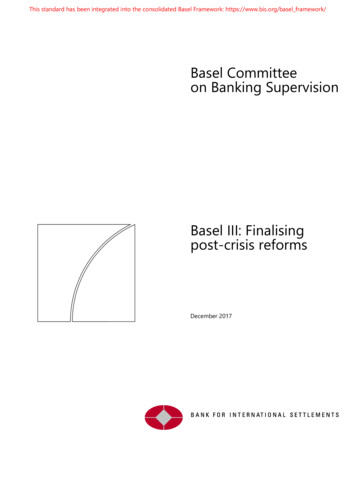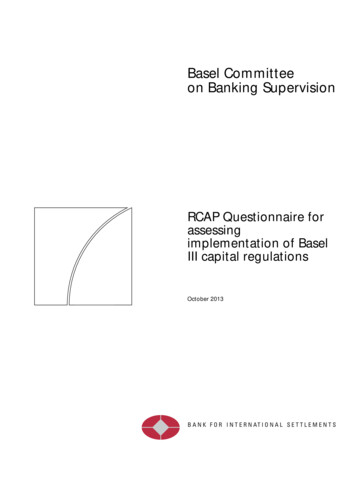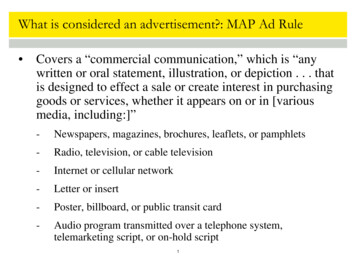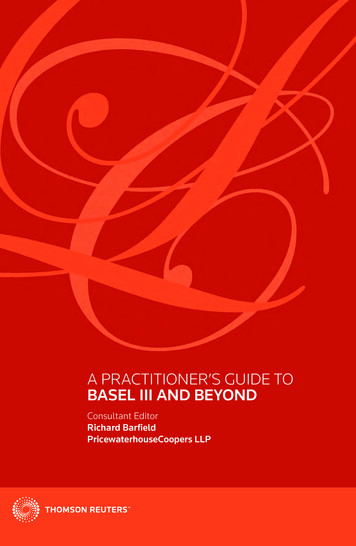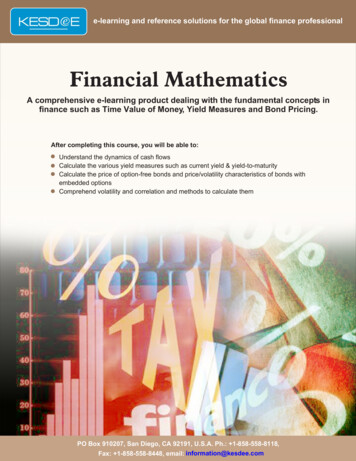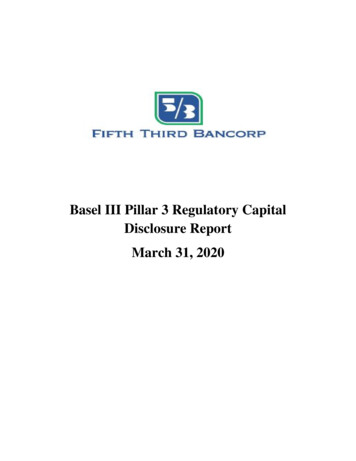
Transcription
Basel III Pillar 3 Regulatory CapitalDisclosure ReportMarch 31, 2020
Table of ContentsIntroductionCapital StructureCapital AdequacyCapital Conservation BufferCredit Risk: General DisclosuresCounterparty Credit Risk-Related ExposuresCredit Risk MitigationSecuritizationsEquities Not Subject to Market Risk RuleInterest Rate Risk for Non-Trading ActivitiesAppendix A – Disclosure Index1235691011121415FORWARD-LOOKING STATEMENTSThis report contains statements that we believe are “forward-looking statements” within the meaning of Section 27A of the Securities Act of 1933, as amended, andRule 175 promulgated thereunder, and Section 21E of the Securities Exchange Act of 1934, as amended, and Rule 3b-6 promulgated thereunder. These statementsrelate to our financial condition, results of operations, plans, objectives, future performance or business. They usually can be identified by the use of forward-lookinglanguage such as “will likely result,” “may,” “are expected to,” “is anticipated,” “potential,” “estimate,” “forecast,” “projected,” “intends to,” or may include othersimilar words or phrases such as “believes,” “plans,” “trend,” “objective,” “continue,” “remain,” or similar expressions, or future or conditional verbs such as “will,”“would,” “should,” “could,” “might,” “can,” or similar verbs. You should not place undue reliance on these statements, as they are subject to risks and uncertainties,including but not limited to the risk factors set forth in our most recent Annual Report on Form 10-K as updated by our Quarterly Reports on Form 10-Q. Whenconsidering these forward-looking statements, you should keep in mind these risks and uncertainties, as well as any cautionary statements we may make. Moreover,you should treat these statements as speaking only as of the date they are made and based only on information then actually known to us. There are a number ofimportant factors that could cause future results to differ materially from historical performance and these forward-looking statements. Factors that might cause such adifference include, but are not limited to: (1) effects of the global COVID-19 pandemic; (2) deteriorating credit quality; (3) loan concentration by location or industryof borrowers or collateral; (4) problems encountered by other financial institutions; (5) inadequate sources of funding or liquidity; (6) unfavorable actions of ratingagencies; (7) inability to maintain or grow deposits; (8) limitations on the ability to receive dividends from subsidiaries; (9) cyber-security risks; (10) Fifth Third’sability to secure confidential information and deliver products and services through the use of computer systems and telecommunications networks; (11) failures bythird-party service providers; (12) inability to manage strategic initiatives and/or organizational changes; (13) inability to implement technology systemenhancements; (14) failure of internal controls and other risk management systems; (15) losses related to fraud, theft or violence; (16) inability to attract and retainskilled personnel; (17) adverse impacts of government regulation; (18) governmental or regulatory changes or other actions; (19) failures to meet applicable capitalrequirements; (20) regulatory objections to Fifth Third’s capital plan; (21) regulation of Fifth Third’s derivatives activities; (22) deposit insurance premiums; (23)assessments for the orderly liquidation fund; (24) replacement of LIBOR; (25) weakness in the national or local economies; (26) global political and economicuncertainty or negative actions; (27) changes in interest rates; (28) changes and trends in capital markets; (29) fluctuation of Fifth Third’s stock price; (30) volatility inmortgage banking revenue; (31) litigation, investigations and enforcement proceedings by governmental authorities; (32) breaches of contractual covenants,representations and warranties; (33) competition and changes in the financial services industry; (34) changing retail distribution strategies, customer preferences andbehavior; (35) risks relating to Fifth Third’s ability to realize the anticipated benefits of the merger with MB Financial, Inc.; (36) difficulties in identifying, acquiringor integrating suitable strategic partnerships, investments or acquisitions; (37) potential dilution from future acquisitions; (38) loss of income and/or difficultiesencountered in the sale and separation of businesses, investments or other assets; (39) results of investments or acquired entities; (40) changes in accounting standardsor interpretation or declines in the value of Fifth Third’s goodwill or other intangible assets; (41) inaccuracies or other failures from the use of models; (42) effects ofcritical accounting policies and judgments or the use of inaccurate estimates; (43) weather-related events, other natural disasters, or health emergencies; and (44) theimpact of reputational risk created by these or other developments on such matters as business generation and retention, funding and liquidity.
Fifth Third BancorpBasel III Pillar 3 Regulatory Capital Disclosures as of March 31, 2020INTRODUCTIONFifth Third Bancorp (the “Bancorp” or “Fifth Third”) is a diversified financial services company headquartered inCincinnati, Ohio. At March 31, 2020, the Bancorp had 185.4 billion in assets, 135.1 billion in deposits and 21.9 billionin total equity. The Board of Governors of the Federal Reserve System (FRB) is the primary regulator of the Bancorp, afinancial holding company. The Bancorp’s principal bank subsidiary is Fifth Third Bank, National Association (the“Bank”), a nationally-chartered bank with banking centers in the United States (U.S.) along with foreign offices located inToronto, Canada, London, United Kingdom and the Cayman Islands. The Bank’s subsidiaries include Fifth ThirdSecurities, Inc. (FTS), which provides retail brokerage services and broker dealer services. The Bancorp’s nonbanksubsidiaries include Fifth Third Community Development Corporation, which invests in projects to create affordablehousing, revitalize business and residential areas, and preserve historic landmarks, as well as Fifth Third ReinsuranceCompany, Ltd., which provides property casualty insurance on credit related consumer loans.The Bancorp’s basis of consolidation for both financial and regulatory accounting purposes is in accordance with U.S.GAAP. The Bancorp’s Consolidated Financial Statements include the accounts of the Bancorp and its majority-ownedsubsidiaries and variable interest entities (VIEs) in which the Bancorp has been determined to be the primary beneficiary.Other entities, including certain joint ventures, in which the Bancorp has the ability to exercise significant influence overoperating and financial policies of the investee, but upon which the Bancorp does not possess control, are accounted for bythe equity method of accounting and not consolidated. Those entities in which the Bancorp does not have the ability toexercise significant influence are generally carried at the lower of cost or fair value. Intercompany transactions andbalances have been eliminated.Section 121 of the Gramm-Leach-Bliley Act allows national banks and insured state banks to establish entities known asfinancial subsidiaries. One of the statutory requirements for establishing a financial subsidiary is that a national bank orinsured state bank must deduct any investment in a financial subsidiary from the bank’s assets and tangible equity incalculating the regulatory capital ratios. Therefore, under the Basel III regulatory capital rules, a bank must deduct theaggregate amount of its outstanding equity investment in a financial subsidiary, including the retained earnings of thesubsidiary, from its common equity tier 1 (CET1) capital. In addition, the assets and liabilities of the subsidiary may not beconsolidated with those of the parent bank for regulatory capital purposes. Therefore, in the calculation of the capital ratiosfor the Bank, the equity investments in FTS and Fifth Third Insurance have been deducted from capital and neither entity’sassets are included in the assets subject to risk-weighting.Basel III OverviewIn December of 2010, and revised in June of 2011, the Basel Committee on Banking Supervision issued Basel III, a globalregulatory framework, to enhance international capital standards. Basel III is designed to materially improve the quality ofregulatory capital and introduces a new minimum common equity requirement. Basel III also raises the minimum capitalrequirements and introduces capital conservation and countercyclical buffers to induce banking organizations to holdcapital in excess of regulatory minimums.In July of 2013, U.S. banking regulators approved the final enhanced regulatory capital rules, which implemented Basel IIIin the U.S. The rules substantially revise the risk-based capital requirements applicable to bank holding companies andtheir depository institution subsidiaries as compared to the previous U.S. risk-based capital and leverage ratio rules, andthereby implement certain provisions of the Dodd-Frank Wall Street Reform & Consumer Protection Act.Basel III has three components (Pillars) including minimum capital requirements, a supervisory review process and marketdiscipline:Pillar 1 – Minimum capital requirements: Establishes the rules by which regulatory capital can be calculated,including defining eligible capital instruments and calculating risk-weighted assets.Pillar 2 – Supervisory review process: Addresses bank-wide governance and risk management, in addition torequiring banks to have an Internal Capital Adequacy Assessment Process.Pillar 3 – Market discipline: Establishes regulatory disclosure requirements, which are designed to allow marketparticipants to assess the risk and capital profiles of banks.Bank holding companies, such as the Bancorp, with total assets greater than 50 billion but less than 250 billion wererequired to develop the systems, processes and controls to report capital ratios under the Basel III Standardized Approach,1
Fifth Third BancorpBasel III Pillar 3 Regulatory Capital Disclosures as of March 31, 2020effective January 1, 2015. Certain requirements of Basel III are subject to phase-in periods extending through the end of2021. The amounts in this report represent the Bancorp’s regulatory capital and risk-weighted assets (RWA) based uponthe transition capital provisions.Basel III ReportingThe Basel III Pillar 3 Regulatory Capital Disclosure Report (Basel III Report) provides the Bancorp’s disclosuresregarding its capital structure, capital adequacy, risk exposures and RWA as required by the Basel III Pillar 3 provisions.The required disclosures apply to the Bancorp, with the exception that each depository subsidiary must also disclosecapital ratios.The Basel III Report should be read in conjunction with the Bancorp’s filing with the U.S. Securities and ExchangeCommission (SEC) - Annual Report on Form 10-K for the year ended December 31, 2019 (2019 Form 10-K), QuarterlyReport on Form 10-Q for the period ended March 31, 2020 (2020 Form 10-Q), and the Consolidated Financial Statementsfor Holding Companies (FR Y-9C) for the period ended March 31, 2020. The Basel III Report has not been audited by theBancorp’s external auditors. The Basel III Disclosure Index (Appendix A) specifies where all required disclosures arereferenced.Capital in the Bancorp’s SubsidiariesThe aggregate amount of surplus capital in the Bancorp’s insurance subsidiaries was 263 million at March 31, 2020.Additionally, as of March 31, 2020, the Bancorp did not have any subsidiaries whose regulatory capital was less than theminimum total capital requirement.Restrictions on Transfer of Funds and CapitalThe dividends paid by the Bank are subject to regulations and limitations prescribed by the OCC. In addition, the Bank issubject to certain restrictions imposed by federal law on extensions of credit to, and certain other transactions with, theBancorp and certain other affiliates, and on investments in stock or securities of the Bancorp and those affiliates. Forfurther information on restrictions on transfers of funds and capital, refer to Note 4 in the 2019 Form 10-K.CAPITAL STRUCTURECapital InstrumentsThe Bancorp’s regulatory capital structure includes common stock, preferred shares, trust preferred securities andqualifying subordinated debt. The terms and conditions of the Bancorp’s capital instruments are described in its annualSEC disclosures. For additional information, refer to Notes 18 and 25 in the 2019 Form 10-K.ASU 2016-13In April 2018, the federal banking regulators proposed transitional arrangements to permit banking organizations to phasein the day-one impact of the adoption of ASU 2016-13, referred to as CECL, on regulatory capital over a period of threeyears. The proposed rule was adopted as final effective July 1, 2019. The phase-in provisions of the final rule are optionalfor a banking organization that experiences a reduction in retained earnings due to CECL adoption as of the beginning ofthe fiscal year in which the banking organization adopts CECL. A banking organization that elects the phase-in provisionsof the final rule for regulatory capital purposes must phase in 25% of the transitional amounts impacting regulatory capitalin the first year of adoption of CECL, 50% in the second year, 75% in the third year, with full impact beginning in thefourth year.In March 2020, the banking agencies issued an interim final rule for additional transitional relief to regulatory capitalrelated to the impact of the adoption of CECL given the disruption in economic activity caused by the COVID-19pandemic. The interim final rule provides banking organizations that adopt CECL in the 2020 calendar year with theoption to delay for two years the estimated impact of CECL on regulatory capital, followed by the aforementioned threeyear transition period to phase out the aggregate amount of benefit during the initial two-year delay for a total five-yeartransition. The estimated impact of CECL on regulatory capital (modified CECL transitional amount) is calculated as thesum of the day-one impact on retained earnings upon adoption of CECL (CECL transitional amount) and the calculatedchange in the ACL relative to the day-one ACL upon adoption of CECL multiplied by a scaling factor of 25%. The scalingfactor is used to approximate the difference in the ACL under CECL relative to the incurred loss methodology. Themodified CECL transitional amount will be calculated each quarter for the first two years of the five-year transition. Theamount of the modified CECL transition amount will be fixed as of December 31, 2021 and that amount will be subject tothe three-year phase out.2
Fifth Third BancorpBasel III Pillar 3 Regulatory Capital Disclosures as of March 31, 2020The Bancorp adopted ASU 2016-13 on January 1, 2020 and elected the five-year transition phase-in option for the impactof CECL on regulatory capital with its regulatory filings as of March 31, 2020.Regulatory Capital, Risk-Weighted Assets and Capital RatiosThe following table summarizes the Basel III minimum and well-capitalized regulatory capital ratios as of March 31,2020.Minimum and Well-Capitalized Regulatory Capital RatiosRatioCET1 capitalTier 1 risk-based capitalTotal risk-based 0Basel III establishes two comprehensive methodologies for calculating RWA, a Standardized Approach and an AdvancedApproach. The Bancorp is subject to the Basel III Standardized Approach for determining risk-weighted assets whichapplies to bank holding companies with total consolidated assets over 50 billion that are not subject to the AdvancedApproach.At March 31, 2020, the Bancorp and Fifth Third Bank, National Association were well-capitalized under Basel III capitalstandards.A reconciliation of regulatory capital elements as they relate to the Bancorp’s Consolidated Financial Statements presentedin the 2020 Form 10-Q, in addition to information regarding the components of capital used in calculating CET1 capital,Tier 1 capital, Tier 2 capital and Total regulatory capital under Basel III transitional requirements for the Bancorp atMarch 31, 2020 are presented in the following table.Reconciliation of Regulatory Capital Elements( in millions)Common stockCapital surplusTreasury stockCommon stock and related surplus, net of treasury stock March 31, 20202,0513,597(5,699)(51)Retained earningsAccumulated other comprehensive income (AOCI)Preferred stockTotal Bancorp shareholders' equity (Consolidated Financial Statements)18,2792,4771,77022,475Less: AOCI (opt-out election)Less: Preferred stockLess: Adjustments and deductionsCET1 capital2,4771,7704,38813,840Preferred stockTier 1 capital1,77015,610Qualifying subordinated debtOther Tier 2 capital adjustmentsTotal regulatory capital2,7381,73320,081 CAPITAL ADEQUACYInternal Capital Adequacy Process (ICAP)The ICAP is a set of integrated risk practices organized around ensuring that Fifth Third can maintain robust capital andliquidity at a high level of confidence. This involves mechanisms to identify, measure, monitor and manage risks acrossthe Bancorp; to ensure that the risk organization informs and guides the Bancorp’s risk decisions from a position ofindependence; and that senior leadership incorporates risk principles into its measurement, decisions and compensation.3
Fifth Third BancorpBasel III Pillar 3 Regulatory Capital Disclosures as of March 31, 2020Sound risk management processes are necessary to support supervisory and management’s confidence in assessments ofrisk profiles and internal capital adequacy assessments. The Bancorp recognizes that an appropriate level of capital shouldexceed the minimum requirement so that all risks of the Bancorp, both on and off-balance sheet, are adequately covered,even during stress events.In addition to consideration of stress events, the excess capital (“cushion”) above the minimum requirements is held toaccount for uncertainty in risk identification, risk mitigation or control and risk quantification (model risk). Based on theenvironment at the time of the assessment, sophistication of measurements and tools employed, key assumptions anddesired solvency level, the Capital Committee reviews capital calculations and analyses and recommends a capital cushionto be held at a specific solvency standard. The recommendation is taken up through the governance structure, ultimately tobe approved by the Risk and Compliance Committee of the Board of Directors.The Bancorp’s ICAP is an ongoing process assessing our capital adequacy relative to our risk profile and risk appetite.Stress testing is intended to capture a variety of potential unfavorable scenarios that are applied across business areas, risktypes and risk events.Fifth Third’s capital planning process assesses both the risks to which the Bancorp is exposed and the risk managementprocesses in place to manage and mitigate those risks. The Bancorp evaluates its capital adequacy relative to its risks andconsiders the potential impact on earnings and capital from economic downturns. The process also incorporates rigorous,forward-looking stress testing.In addition to capital as a buffer against risk, the Bancorp also carefully manages its liquidity and has in place acomprehensive system of measures and practices to guard against a lack of liquidity.Fifth Third’s Board of Directors is responsible for setting the risk appetite of the Bancorp, through its review and approvalof the company’s Risk Appetite Framework, and ensuring that its capital and risk capacity is sufficient to cover all riskexposures under normal and stressed conditions. The Board of Directors is also responsible for reviewing and challengingmanagement’s methodologies that are utilized to measure, monitor and manage risk exposures and capital needs; forapproving all policies that govern the capital management process at the Bancorp; and for approving management’s capitalaction plans and recommendations, including potential dividend payments, share repurchases and redemptions.Comprehensive Capital Analysis and Review (CCAR)The FRB requires bank holding companies with consolidated assets of greater than 100 billion but less than 250 billionto develop and maintain a capital plan which is reviewed and approved by the company’s board of directors or adesignated subcommittee thereof. Under the rule, the company’s capital plan must include detailed descriptions of thefollowing: the bank holding company’s internal processes for assessing capital adequacy; the policies governing capitalactions such as common stock issuances, dividends and share repurchases; and all planned capital actions over a ninequarter planning horizon. Further, the bank holding company is also subject to the Horizontal Capital Review, in which theFRB reviews the processes and methodologies that are employed by the company through the performance of the capitaladequacy assessment. Under the revised guidance, bank holding companies with consolidated assets of greater than 100billion but less than 250 billion will be required to participate in the 2020 CCAR assessment. In the CCAR assessment,the FRB evaluates whether large bank holding companies have sufficient capital during periods of economic and financialstress and have robust, forward-looking capital assessment and planning processes in place that address each company’sunique risk to enable them to have the ability to absorb losses under certain stress scenarios.The Bancorp’s capital planning process and other capital adequacy stress testing activities are integrated into and arefoundational to the Bancorp’s ICAP process.4
Fifth Third BancorpBasel III Pillar 3 Regulatory Capital Disclosures as of March 31, 2020The following tables present information on the RWA components included within the regulatory capital ratios under theStandardized Approach for Fifth Third Bancorp and the capital ratios for Fifth Third Bancorp and Fifth Third Bank,National Association at March 31, 2020.Risk-Weighted Assets( in millions)On-Balance SheetExposures to sovereign entities(a)Exposures to depository institutions, foreign banks and credit unionsExposures to public sector entitiesCorporate exposuresResidential mortgage exposures(b)Consumer loan exposure(c)High volatility commercial real estate (HVCRE) loans(b)Past due loansOther assetsSecuritization exposuresEquity exposuresMarch 31, 2020 Off-Balance Sheet and Market RiskLetters of creditUnused commitments:Original maturity of one year or less, excluding asset-backed commercial paper conduitsOriginal maturity greater than one yearCentrally cleared derivativesAll other off-balance sheet items(d)Market-risk-weighted assetsTotal Risk-Weighted 991,586 1,59117,281114,241632147,756(a) Exposures to, and portions of exposures that are directly and unconditionally guaranteed by, the U.S. government, its agencies and theFederal Reserve Board receive 0% risk-weight.(b) Includes related exposures that are 90 days or more past due or on nonaccrual.(c) Includes credit card, automobile and other consumer loans and leases that do not fall under residential mortgage.(d) Includes over-the-counter derivatives, repo-style transactions and other off-balance sheet items.Regulatory Capital RatiosBasel IIIFifth Third BancorpFifth Third Bank, N.A.9.37%11.36%10.5611.3613.5913.17March 31, 2020CET1 capitalTier 1 risk-based capitalTotal risk-based capitalCAPITAL CONSERVATION BUFFERBasel III incorporates a capital conservation buffer whereas the Bancorp will be required to hold a capital conservationbuffer in an amount greater than 2.5% of total risk-weighted assets to avoid limitations on capital distributions anddiscretionary bonus payments to executive officers.The Bancorp’s capital conservation buffer is the lowest of the following ratios:(i)the banking organization’s common equity tier 1 capital ratio minus its minimum common equitytier 1 capital ratio of 4.5%;(ii)the banking organization’s tier 1 capital ratio minus its minimum tier 1 capital ratio of 6.0%; and(iii)the banking organization’s total capital ratio minus its minimum total capital ratio of 8.0%.If the Bancorp’s common equity tier 1, tier 1 or total capital ratio is less than or equal to its minimum common equity tier1, tier 1 or total capital ratio, respectively, the Bancorp’s capital conservation buffer is zero.5
Fifth Third BancorpBasel III Pillar 3 Regulatory Capital Disclosures as of March 31, 2020The following table illustrates the relationship between the capital conservation buffer and maximum payout ratio.CAPITAL CONSERVATION BUFFER AND MAXIMUM PAYOUT RATIOCapital Conservation Buffer (as a percentageof standardized total risk-weighted assets)Greater than 2.5%Less than or equal to 2.5%, and greater than 1.875%Less than or equal to 1.875%, and greater than 1.25%Less than or equal to 1.25%, and greater than 0.625%Less than or equal to 0.625%Maximum Payout Ratio (as a percentageof eligible retained income)No payout ratio limitation applies60%40%20%0%The maximum dollar amount that a banking organization could pay out in the form of capital distributions or discretionarybonus payments during the current calendar quarter would be equal to the maximum payout ratio, multiplied by thebanking organization’s eligible retained income. Basel III defines eligible retained income as a banking organization’s netincome (as reported in the banking organization’s quarterly regulatory reports) for the four calendar quarters preceding thecurrent calendar quarter, net of any capital distributions and associated tax effects not already reflected in net income.Capital Conservation BufferMarch 31, 2020CET1 capitalTier 1 risk-based capitalTotal risk-based capitalRequired Buffer (effective 1/1/19)March 31, 2020 Calculated BufferFifth Third Bancorp9.37%10.5613.59Minimum DIT RISK: GENERAL DISCLOSURESEnterprise Risk ManagementManaging risk is an essential component of successfully operating a financial services company. The Bancorp’s riskmanagement approach includes processes for identifying, assessing, managing, monitoring and reporting risks. TheEnterprise Risk Management division, led by the Bancorp’s Chief Risk Officer, ensures the consistency and adequacy ofthe Bancorp’s risk management approach within the structure of the Bancorp’s operating model. In addition, the InternalAudit division provides an independent assessment of the Bancorp’s internal control structure and related systems andprocesses.The assumption of risk requires robust and active risk management practices that comprise an integrated andcomprehensive set of activities, measures and strategies that apply to the entire organization. The Bancorp has establisheda Risk Appetite Framework, approved by the Board of Directors, that provides the foundations of corporate risk capacity,risk appetite and risk tolerances. The Bancorp’s risk capacity is represented by its available financial resources. Riskcapacity sets an absolute limit on risk-assumption in the Bancorp’s annual and strategic plans. The Bancorp understandsthat not all financial resources may persist as viable loss buffers over time. Further, consideration must be given toregulatory capital buffers required per capital policy targets that would reduce risk capacity. Those factors take the form ofcapacity adjustments to arrive at an operating risk capacity which represents the operating risk level the Bancorp canassume while maintaining its solvency standard. The Bancorp’s policy currently discounts its Operating Risk Capacity bya minimum of 5% to provide a buffer; as a result, the Bancorp’s risk appetite is limited by policy to, at most, 95% of itsOperating Risk Capacity.Credit Risk ManagementThe objective of the Bancorp’s credit risk management strategy is to quantify and manage credit risk on an aggregateportfolio basis, as well as to limit the risk of loss resulting from the failure of a borrower or counterparty to honor itsfinancial or contractual obligations to the Bancorp. The Bancorp's credit risk management strategy is based on three coreprinciples: conservatism, diversification and monitoring. The Bancorp believes that effective credit risk managementbegins with conservative lending practices. These practices include conservative exposure and counterparty limits andconservative underwriting, documentation and collection standards. The Bancorp's credit risk management strategy alsoemphasizes diversification on a geographic, industry and customer level, as well as ongoing portfolio monitoring and6
Fifth Third BancorpBasel III Pillar 3 Regulatory Capital Disclosures as of March 31, 2020timely management reviews of large credit exposures and credits experiencing deterioration of credit quality. Creditofficers with the authority to extend credit are delegated specific authority amounts, the utilization of which is closelymonitored. Underwriting activities are centrally managed and Enterprise Risk Management manages the policy and theauthority delegation process directly. The Credit Risk Review function provides objective assessments of the quality ofunderwriting and documentation, the accuracy of risk grades and the charge-off, nonaccrual and reserve analysis process.The Bancorp’s credit review process and overall assessment of the adequacy of the allowance for credit losses is based onquarterly assessments of the probable estimated losses inherent in the loan and lease portfolio. The Bancorp uses theseassessments to promptly identify potential problem loans or leases within the portfolio, maintain an adequate reserve andtake any necessary charge-offs. The Bancorp defines potential problem loans and leases as those rated substandard that donot meet the definition of a nonaccrual loan or a
Fifth Third Bancorp (the "Bancorp" or "Fifth Third") is a diversified financial services company headquartered in . The Bancorp's basis of consolidation for both financial and regulatory accounting purposes is in accordance with U.S. . qualifying subordinated debt. The terms and conditions of the Bancorp's capital instruments .
